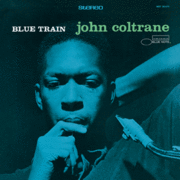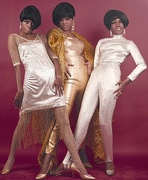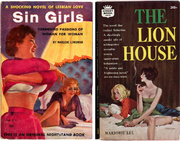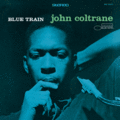
When Gertrude “Ma” Rainey—known as “The Mother of Blues”—sang, “It’s true I wear a collar and a tie, … Talk to the gals just like any old man,” in 1928’s “Prove It on Me,” she was flirting with scandal, challenging the listener to catch her in a lesbian affair. It might not seem like a big deal to us now, but back then, pursuing same-sex relations could get you thrown in jail.
“It was under the cover of night, because they could be prosecuted for same-sex activity.”
The good news for women-loving chanteuses like Rainey, Bessie Smith, and Gladys Bentley is that blues music in the 1920s was so far under the radar of mainstream America, female blues singers could get away with occasionally expressing their unconventional desires. That said, they all felt obligated to produce song after song about loving and losing men.
“I don’t want to overplay the significance of the three songs that Ma Rainey wrote and recorded that had some references to lesbianism and homosexuality,” says Robert Philipson, who directed the 2011 documentary, “T’Ain’t Nobody’s Bizness: Queer Blues Divas of the 1920s.” “That’s a handful out of hundreds and hundreds of blues songs that were recorded. The fact that there were any was remarkable, given the times. You certainly never saw it in any other part of American culture.”

Top: Cabaret singer and pianist Gladys Bentley, who performed in a tuxedo, drew a crowd to the Clam House in Harlem in the 1920s. (Postcard image via QueerMusicHeritage.us) Above: Ma Rainey, “The Mother of the Blues,” sang about pursuing women on a handful of tunes. (1917 image via WikiCommons)
A writer and lecturer with a Ph.D. in comparative literature, Philipson got intrigued by hints such as these when he was starting out as a filmmaker and preparing for a course on the early 20th century African American art and literature explosion known as the Harlem Renaissance. “I kept running into these tidbits about this person being gay or that person being bisexual,” he says.
These clues intrigued Philipson, who saw the potential for a documentary—and in 2008, he finished his first film, “Take the Gay Train,” which traces the threads of gay sensibility running through the Harlem Renaissance. Often, though, the desire to prove that black Americans, less than half a century out of slavery, could be as artistic and literate as their white counterparts went hand in hand with adopting the “proper Christian values” of middle-class Edwardians.

Mona’s, the first openly lesbian club, began in a basement in San Francisco’s North Beach district in 1936. Bentley was a regular performer here. (Via ashtray collector Hock_venom’s Flickr page)
The blues community, however, had no such concerns about respectability, and that’s where Philipson found the most references to homosexuality. Which is why, three years after “Gay Train,” he followed up with another documentary, this time focusing exclusively on female blues singers with lesbian proclivities.
As it turns out, the blues world was the perfect realm for people who were thought of as “sexual deviants” to inhabit, in part because people in the entertainment industry had far more leeway to flout sexual mores. But blues music also thrived far outside the scope of the dominant white American culture in the early 20th century. In Jazz Age speakeasies, dive bars, and private parties, blue singers had the freedom to explore alternative sexuality, and on a rare occasion, they even expressed it in song.

Ma Rainey’s protégé Bessie Smith was bisexual and promiscuous on the road.
“In lyrics, they talk about ‘bulldykers,’ which is they called butch lesbians at that time, or ‘BD women,’ ‘BD’ being short for bulldykers,” Philipson says. “There were references to being ‘in the life,’ which was understood to mean being homosexual.”
In 1930’s “The Boy in the Boat,” Ma Rainey’s protégé, Bessie Smith sang, “When you see two women walking hand in hand, just look ’em over and try to understand: They’ll go to those parties—have the lights down low—only those parties where women can go.” A married woman who pursued affairs with both sexes on the road, Smith is known to have exploded at Lillian Simpson, her lover at the time, “I got twelve women on this show, and I can have one every night if I want it.”

Bentley with bandleader Willie Bryant in 1936. (Via QueerMusicHeritage.us)
With short cropped hair and a tuxedo, the lesser-known Gladys Bentley commandeered the crowd at Harlem’s Clam House in the 1920s, singing cabaret, tickling the piano keys, and flirting shamelessly with the women in the audience. The only one of these women to openly exploit her lesbian identity, she was known for taking popular songs and giving them lewd lyrics; and she asked the audience to help her improvise naughty lines.
“Harlem’s 133rd Street was called ‘Jungle Alley,’ because there were so many nightclubs on it,” Philipson says, explaining that Harlem had the only Roaring Twenties jazz clubs and cabarets in the country that drew white “tourists” curious about “race music.” “The Clam House was famous because it had Bentley, reveling in her image as a ‘bulldyker.’ Because of her, it became a place where black lesbians and gay men would go to hang out. White sightseers from downtown would check out her show as well.”

This 1932 map of Harlem nightclubs show Gladys’ Clam House, boasting that she wears “a tuxedo and highhat.” (Via YeahMan.com, Ventura, CA, Swing Dance Club)
Other blues singers delving into “the life” tried to keep it behind closed doors—and the lack of modern technology and online celebrity-gossip hounds made it possible to do so. In the ’20s, blues and jazz vocalist Ethel Waters, a lesbian, was involved with a dancer named Ethel Williams, performing together as “The Two Ethels,” according to a 2007 biography of Waters by Stephen Bourne. They even lived together as lovers, a disreputable act at the time.
Because she succeeded in the more refined European cabaret scene, blues singer and songwriter Alberta Hunter concealed and refused to speak about her lesbianism, according to Bonnie Zimmerman’s encyclopedia “Lesbian Histories and Cultures.” Hunter’s biographer Frank C. Taylor wrote that the vocalist, who also lived with her long-term girlfriend, Lottie Tyler, would cringe every time a lesbian performer, like her friend Ethel Waters, would have a lover’s spat in public.

Ethel Waters got her start on the vaudeville circuit. Here, she poses for a publicity photo for the 1929 film “On With the Show,” in which she sings “Birmingham Bertha.” (Via songbook1.wordpress.com)
“What was occurring was occurring clandestinely or within urban settings that were more or less secret and difficult to penetrate,” Philipson says. “It was very much under the cover of night, because they could be prosecuted for same-sex activity. There were some open demonstrations of alternative sexuality in the Harlem Renaissance and in Greenwich Village in the late ’20s. Take for example, ‘the Pansy Craze,’ where Harlem drag balls were attended by sightseers and celebrities. There were also drag performers in cabarets, but that was very much the exception.”

Alberta Hunter was hush-hush about her lesbian lifestyle. (Via JazzAgeMusic.blogspot.com)
The blues itself was condemned by black preachers. After the turn of the century, smokey blues cabarets proliferated in urban areas with large African American populations, which would draw almost exclusively black audiences, who made Ma Rainey and Bessie Smith stars. (The Cotton Club in Harlem, which only allowed white audience members to watch black performers, was a notable exception.) By the 1920s, record labels like Decca, Columbia, Paramount, and RCA were producing shellac 78s targeted toward African American consumers, known as “race records,” and these included popular blues tunes.
Around the same time, urban industrialization, the development of the electrical grid, and the introduction of cars gave young women more personal money, free time, and options than they ever had before. In the late 1910s, so-called “flappers” rejected the constricting corsets of their Victorian mothers, wearing short haircuts and skin-exposing dresses that were both androgynous and provocative. These women went out dancing and drinking at clubs, and embraced promiscuity.
It’s likely that the flapper movement took some cues from these blues divas, who were on the cutting edge of that sexual revolution in the 1910s, flouting conventions about proper women left and right. “They drank, and they dressed in a flashy and flamboyant manner,” Philipson says. “They were not subservient to men in any fashion, and that was not the model of post-Victorian womanhood that was in mainstream culture at the turn of the century.

Alberta Hunter, far right, performs vaudeville. (Courtesy of Chris Albertson)
“All these women had come from working-class, or even more marginal backgrounds, in one of the worst periods of racial segregation in American history,” he continues. “And they were making money and careers for themselves during a period when that was very unusual for black women. But oftentimes, having come from poverty, they didn’t know how to hold on to money.”
“They drank, they were not subservient to men in any fashion—not the mainstream model of womanhood.”
Blues songs celebrating booze and lust may also have roots in “coon songs” from 19th-century minstrel shows. At these popular Victorian touring shows, white actors in blackface played racist caricatures of African Americans as simple, lazy buffoons with insatiable appetites for food, alcohol, and sex.
In the 1840s, William Henry Lane and Thomas Dilward became the first black actors to play minstrels. By the late 1800s, all-black minstrel troupes were taking off, and while they were upholding stereotypes, they often worked to slyly subvert the racist jokes and make subtle jabs at white supremacy. (In his 1974 book Blacking Up, Robert Toll describes one jubilee from a black minstrel show that depicts heaven as a place “where de white folks must let the darkeys be,” where they wouldn’t be “bought and sold.”) When vaudeville variety shows supplanted minstrel shows, black performers were still expected to play minstrel-type characters.

Ma Rainey, who was bisexual, got her stage name when she married vaudeville performer Pa Rainey. (Via NotesOnTheRoad.com)
In fact, Ma Rainey, Bessie Smith, and Ethel Waters all got their start singing and dancing on the turn-of-the-century vaudeville circuit. So it’s not surprising these women went on to perform several songs filled with sexual innuendo of what became known as dirty or “hokum” blues. In Waters’ 1928 song “My Handy Man,” she sings, “He shakes my ashes, greases my griddle, churns my butter, strokes my fiddle. My man is such a handy man!”
To Philipson, the dirty blues stands in contrast to the upright, ambitious lifestyle promoted by the leadership class of African Americans that W.E.B. Du Bois referred to as “The Talented Tenth” in 1903, who were establishing black colleges and assimilating in the world of white Edwardians.

Ma Rainey, pictured in 1925, and other blues divas of the era usually performed with a backing band. (Via NotesOnTheRoad.com)
“The black bourgeoisie, the aspiring post-Victorian middle-class blacks, were very hostile to homosexuality,” Philipson says. “They were not the majority of the black community, but they were trying to set themselves up as the leaders. Post-Victorian morals were that you have no premarital sex, you get married, you raise a family, you stay together all of your life, you go to church, and you raise proper Christian children who take their place in society and reproduce.”
Clearly, these lesbian-leaning blues singers were forging their own paths in a shifting cultural landscape. “No time to marry, no time to settle down,” Bessie Smith sang on 1926’s “Young Woman’s Blues.” “I’m a young woman, and I ain’t done runnin’ around.”
(For more information on Robert Philipson and his documentaries, visit the Shoga Films site. Recommend reading: Eric Garber’s paper, “A Spectacle in Color: The Lesbian and Gay Subculture of Jazz Age Harlem”; Bitch Magazine’s article, “Adventures in Feministory: Gladys Bentley”; Chris Albertson’s paper, “Lesbianism in the Life of Bessie Smith” and his book “Bessie“; Stephen Bourne’s book, “Ethel Waters: Stormy Weather”; Frank C. Taylor’s book, “Alberta Hunter: A Celebration in Blues”; Bonnie Zimmerman’s encyclopedia, “Lesbian Histories and Cultures.” If you buy something through a link in this article, Collectors Weekly may get a share of the sale. Learn more.)

 Black Glamour Power: The Stars Who Blazed a Trail for Beyoncé and Lupita Nyong'o
Black Glamour Power: The Stars Who Blazed a Trail for Beyoncé and Lupita Nyong'o
 Secrets of the Blue Note Vault: Rediscovering Monk, Blakey, and Hancock
Secrets of the Blue Note Vault: Rediscovering Monk, Blakey, and Hancock Black Glamour Power: The Stars Who Blazed a Trail for Beyoncé and Lupita Nyong'o
Black Glamour Power: The Stars Who Blazed a Trail for Beyoncé and Lupita Nyong'o When Being a Lesbian Was Profitable, For Men
When Being a Lesbian Was Profitable, For Men Blues RecordsThe dominant gene in the DNA of rock ’n’ roll comes from the blues, which i…
Blues RecordsThe dominant gene in the DNA of rock ’n’ roll comes from the blues, which i… Mari Tepper: Laying it on the Line
Mari Tepper: Laying it on the Line Nice Ice: Valerie Hammond on the Genteel Charm of Vintage Canadian Costume Jewelry
Nice Ice: Valerie Hammond on the Genteel Charm of Vintage Canadian Costume Jewelry How Jim Heimann Got Crazy for California Architecture
How Jim Heimann Got Crazy for California Architecture Modernist Man: Jock Peters May Be the Most Influential Architect You've Never Heard Of
Modernist Man: Jock Peters May Be the Most Influential Architect You've Never Heard Of Meet Cute: Were Kokeshi Dolls the Models for Hello Kitty, Pokemon, and Be@rbrick?
Meet Cute: Were Kokeshi Dolls the Models for Hello Kitty, Pokemon, and Be@rbrick? When the King of Comedy Posters Set His Surreal Sights on the World of Rock 'n' Roll
When the King of Comedy Posters Set His Surreal Sights on the World of Rock 'n' Roll How One Artist Makes New Art From Old Coloring Books and Found Photos
How One Artist Makes New Art From Old Coloring Books and Found Photos Say Cheese! How Bad Photography Has Changed Our Definition of Good Pictures
Say Cheese! How Bad Photography Has Changed Our Definition of Good Pictures Middle Earthenware: One Family's Quest to Reclaim Its Place in British Pottery History
Middle Earthenware: One Family's Quest to Reclaim Its Place in British Pottery History Fancy Fowl: How an Evil Sea Captain and a Beloved Queen Made the World Crave KFC
Fancy Fowl: How an Evil Sea Captain and a Beloved Queen Made the World Crave KFC
And, your readers may want to hear the music of Gladys Bentley, including some unreleased material, at the edition of Queer Music Heritage featuring her, along with a thorough resource section, here:
http://www.queermusicheritage.us/feb2013.html
“It is better to be under the radar than on it in any capacity”
–Terminal Lance
Why is there no mention of Lucille Bogan? She is the first person I thought of when I saw the article’s title.
Also, if you’ve got the time, check out this fascinating book by James Wilson:
http://www.amazon.com/Bulldaggers-Pansies-Chocolate-Babies-Triangulations/dp/0472034898/
Great article. I am an enormous admirer of Gladys Bentley; I have many of her original recordings, and someone ought to do a biography of her! One of the more strange and sad moments of her life came late, after she’d been subjected to an early form of anti-gay “therapy” and gotten married to a purported African prince, when she appeared as a guest on Groucho Marx’s “You Bet Your Life” — she belted ’em out as powerfully as ever, and had Groucho tapping his toes in appreciation!
Thanks Lisa for a great article!
Bessie Smith very well might’ve sang it in the ’30’s, but she did not record ‘The Boy in the Boat”. She did record a song in 1926 called “Squeeze Me”, written by Fats Waller and purportedly derived from “The Boy in the Boat”.
Very interesting article!
For me it just affirms that Black gay, lesbian and transgenderpersonshavealways been a part of our community, even those those labels were not present many yearrs ago. My one affirmation as a young man was when my aunt showed me a picture of my great uncle, a very handsome man who danced with Josephine Baker. She tolde
” we loved him to death and we love you, so don’t you ever think we we won’t love you.” I have a photograph of him on my wall today as a an historical affirmation of who I am..a proud same gender loving black man.
That is a treasured part of my history.
As one of your contributors says; Where is the coverage on Lucille Bogan???Her “BD Woman’s Blues” on ARC is as well-known (in blues circles) as Ma Rainey’s “Prove It On Me Blues” o n the Paramount label. Rated up there with Ma, Lucille’s infamous “Shave ‘Em Dry” still cannot be played on BBC radio today. Shame the researcher obviously stuck to the jazz scene instead of digging deeper into the actual blues scene! Check out my multi-part essay on the earlyblues.com website run by my good friend Alan White.
Absolutely fascinating and well-written.
That was a nice watered down version for public consumption. It was much more deeper and dirty than what you are describing. This comes across more like a high school theme paper. Know your time frame a little better. Flappers were not in the 1910’s. Decca and RCA were not around at that time. Black Swan, Paramount, Black Patti, Okeh and Vocalion were your big blues labels. Columbia was too to a certain degree but not quite as prolific as the others. If you are wanting to name “naughty” songs then you need to do just a little big more research. Won’t take much because there are hundreds of songs you will stumble across that are much more famous and biting than the ones you have listed. Expand – explore. Just hearing Ruby Smith’s interviews about her aunt Bessie Smith will pretty much tell you everything you ever wanted to know. LOL. People tend to look at the gay black culture of that era in the same dimensions as the current era. Secret. Dangerous. Shhhhh. Naughty. It was a very, very common thing! Very much in the open especially among show people. The famous buffet flats that catered to all kinds of sexual interests was totally left out of this article. It was a whole subculture. And it made it sound like gays could only practice their voodoo at night! True there’s an upswing in activity at night because that’s when all the clubs and nightlife are going on. But its not to help conceal, hide or protect. It’s still that way and continues to be nocturnal. My Mother used to say, “Nothing good ever happens after midnight.” Oh yeah? She ain’t been where I’ve been! LOL
Beautifully written and fascinating read! I have seen the clip of Gladys B. on « You Bet Your Life » He was a hardass but he surely could admire talent like that. He was so gracious with her, atypical for a big white celebrity in those days. She was saucy and so charismatic!
You’ve got your terms mixed up. “Bull-dyke” is a later term; the original term was “bull-dagger”. There is no “bull-dyker”.